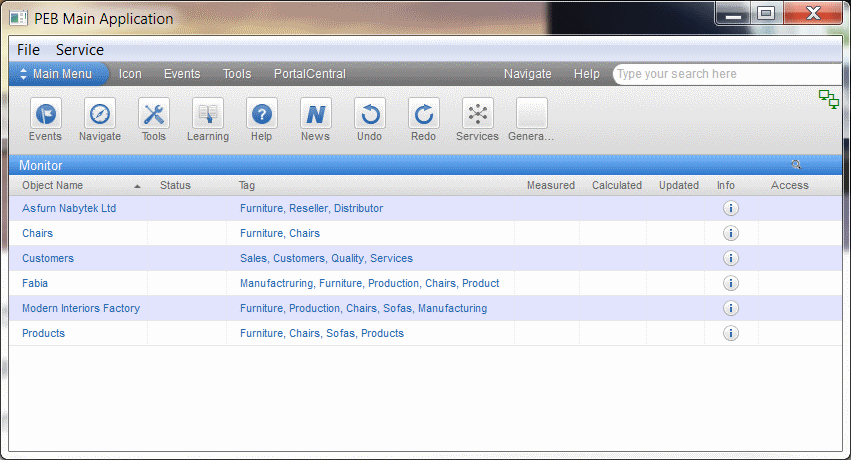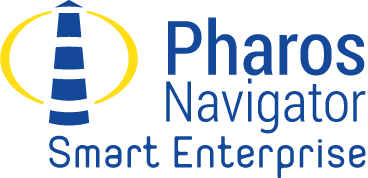What are the ideas behind the solution and how
it works?
Any modern organization
of people is a complex, multi-dimensional and unique system having variety of internal
and external objects continuously changing over time. Such objects include
employees, machinery and instruments, departments, e.g. production floor, sales,
transportation, as well as partners, customers, suppliers as well organization
as a whole.
Organizational
processes need integrity, be measured up in reality, increasingly monitored providing
a comprehensive picture from holistic view to small issues which occasionally can
quickly grow into large cause of problems. The achievements and results provide
data evidence of the past has to be taken into consideration while formulating
the development concepts for the future. The desirable future needs formulation
of options in developments, risks and resilience strategies to mitigate uncertainty.
Most of such
objects have dynamic properties called “Key indicators” which represent various
“processes” of object change. The combination of actual values of each such property
at any particular moment of time results in some object state which is defined by
and for people in convenient common human terms such as “OK”, “Normal”, “Under
control”, “Bad”, Out of Order”, etc.
Having
principal problems in dealing with multiple flows of information people
developed impressive capacity to replace the object complexity by using the combination
of two object properties “Object Name” and “Object State” in understanding and
exchange of information about them. The common examples are “This business is
in a good shape” or “They failed but recovering now”, “Sales are great”, “The
conveyer is in repair”, “The employee efficiency is not sufficient”.
This highly
compressed resulting information like “Good”, “Bad” or “Out of order”,
“Acceptable”, “Not-appropriate”, “Stable”, “Right”, “Wrong”, etc. is sufficient
for human beings to answer the main question:
Does current object state require any corrective
actions e.g. its detailed analysis, interventions?
The Pharos Navigator
facilitates and expands ability of management and specialists to have the right
answers to this question in variety of practical life matters and in their
analysis of relevant content.
The operation in brief
The Pharos Navigator
enterprise server automatically
- reads measurements from relevant data sources defined
by local users regarding each object of monitoring
- calculates all object indicators defined by
local users as its dynamic parameters
- identifies current state of each indicator as
defined by local users
- identifies current object state as defined by
local users
- stores results in local enterprise database
- promptly updates all authorized users monitoring
particular objects and processes
- presents various instruments for analysis and
preparation of decisions using the data about object change store locally in
server database.
The
information is sent to common user devices such as tablets, notebooks, personal
computers and mobile phones in near real time and presented in a way easy for understanding
and interpretation.
The users are
empowered to customize and adapt all operations to their needs including
- Definition of objects
- Its optional states and rules of transition
- Formulating necessary indicators and their
formulas
- Selecting sources of data for indicators
- Presenting the results on user devices.
After importing
every new measurement data the server runs calculations of multiple indicators and
objects which are influenced by this information, identifies current state of each
object at particular moment of time and sent detailed updates to all users
authorized to monitor and analyze the object.
The
presentation of object state and its relevant details is made interactively in secure
Pharos Navigator client applications “Monitor” and “Reports” running on user
devices such as tables, notebooks, mobiles.
The Pharos Navigator
enterprise platform allows monitoring of the whole organization, its divisions,
products and services, customers and suppliers, sales and production, employees
and machines as well as business partners under the following conditions:
- There are measurements of target object
properties implemented continuously and periodically e.g. in departments, branches, etc.
- The relevant source data is saved in some
electronic storage, e.g. application like MS Excel, Calc (OpenOffice/LibreOffice),
databases, etc.
- Pharos Navigator server can access the data storage
via some communication network to import the source data (e.g. Internet or
WLAN/LAN, cellular, etc)
- Object indicators describing objects properties
are formulated and tested by local users
- The set of optional each object states and
rules of transition between these states is formulated by local users
The Pharos Navigator
allows automatic adaptation of the object dynamic parameters to its unknown
behavior and facilitates development of user knowledge about change of object indicator
targets.
The results
are stored in the database on the server and used for variety of related applications
including business analytics, data mining, etc.
The
platform supports implementation of major international standards
including as follows:
- ISO 9000 and ISO 9001 Quality Management
- ISO 14000 Environmental management
- ISO 15504 Information technology — Process
assessment
- ISO 17025 General requirements for the
competence of testing and calibration laboratories
- OHSAS 18000, Health and Safety
- ISO 19011 Management systems auditing
- ISO 26000 Social Responsibility for Sustainable
Development
- ISO 31000 Risk management
- ISO 50001 Energy management
The sample enterprise as object
The examples
of objects are available in the portal as “Sample demos”. Some of them are provided
with server software download as a object templates or as add on services.
The first sample
presents manufacturing enterprise “Modern Interiors Factory” producing
furniture sets. Its indicators include Sales, Customers, Production, Quality, Customer
service index, Performance, Revenue, Expenses, Profits as well as optional
definitions of efficiency and productivity. The business data are real and
based on one of case studies implemented in Pharos Business Navigator for UNIDO between 1998-2008.
The Portal Central
visitors can use examples for analyzing the application content and
considering own objects development. After subscribing to service and
installing the server locally one can use the sample to make own objects for
his/her business and industry. It includes identification of indicators
reflecting local technologies, ways of running business, sources of energy,
environment, pollution, etc., everything necessary to meet requirements of enterprise
management, its owners or stakeholders.
Additionally
Pharos Navigator platform may be applied to monitoring and analyzing of
- Groups
of organizations integrated under single supervision or ownership
- Developments
in particular geographic regions and/or industries providing powerful managerial
and analytic tool for stakeholders.
- Environment including urban areas, regions, etc.
- Urban areas life quality
- Healthcare
- Social developments
- Education (learning of new high tech digital applications in IT, quality of educational services, training, etc)
Welcome to new digital world of measuring and analyzing objects of your life!


